As the colder months approach, it’s essential to prepare your tropical hibiscus for winter to ensure it thrives and blooms again next season. One crucial aspect to remember is that hibiscus plants will soon produce new growth, making it necessary to provide them with the right care during the winter months.
When it comes to overwintering hibiscus plants, bringing them indoors is often the best solution to protect them from harsh winter conditions. These plants thrive when provided with bright light and warm temperatures, mimicking the tropical environment they prefer.
During the winter, it’s crucial to maintain consistent moisture for your hibiscus plant. While it needs regular watering, ensure that you do not allow the plant to stand in water. This practice is beneficial not only for hibiscus but for all houseplants, preventing root rot and other issues that can arise from overwatering.
To successfully overwinter your tropical hibiscus, consider dedicating a bright indoor location where the plant can receive ample sunlight. A sunny window or a room with grow lights can provide the necessary light to keep your hibiscus healthy and encourage growth during the winter months.
While hibiscus plants can adapt to indoor conditions, it’s essential to monitor humidity levels in your home. Tropical hibiscus plants thrive in humid environments, so consider using a humidifier or placing a tray of water near the plant to increase moisture levels.
During the winter, your hibiscus plant may benefit from occasional pruning to promote new growth and maintain its shape. Remove any dead or damaged branches, and trim back leggy growth to encourage a fuller and healthier plant for the upcoming growing season.
Regularly inspect your hibiscus plant for pests, as indoor environments can sometimes attract various insects that can damage the plant. If you notice any pests, be sure to tackle the issue promptly with organic pest control methods to protect your hibiscus.
While hibiscus plants are relatively low maintenance during the winter months, ensure you continue to provide them with proper care. Keep an eye on soil moisture levels, adjust watering as needed, and fertilize the plant sparingly to support growth without overfeeding.
Consider rotating your hibiscus plant occasionally to ensure all sides receive adequate light exposure, promoting even growth and preventing leggy or lopsided growth. This simple step can make a significant difference in the overall health and appearance of your plant.
As the winter months progress, pay attention to temperature fluctuations in your home, ensuring your hibiscus is not exposed to cold drafts or sudden temperature changes. Consistent indoor temperatures will help your plant thrive until it’s ready to transition back outdoors in the spring.
Remember that transitioning your hibiscus back outdoors in the spring requires a gradual process to acclimate the plant to outdoor conditions. Start by placing it in a sheltered location with filtered sunlight, gradually increasing exposure to direct sunlight over time to prevent sunburn and stress on the plant.
In conclusion, wintering a hibiscus plant successfully involves bringing it indoors, providing adequate light and warmth, maintaining proper moisture levels, occasional pruning, pest management, and consistent care throughout the winter months. By following these guidelines, you can ensure your hibiscus stays healthy and ready to bloom when the warmer weather returns.

